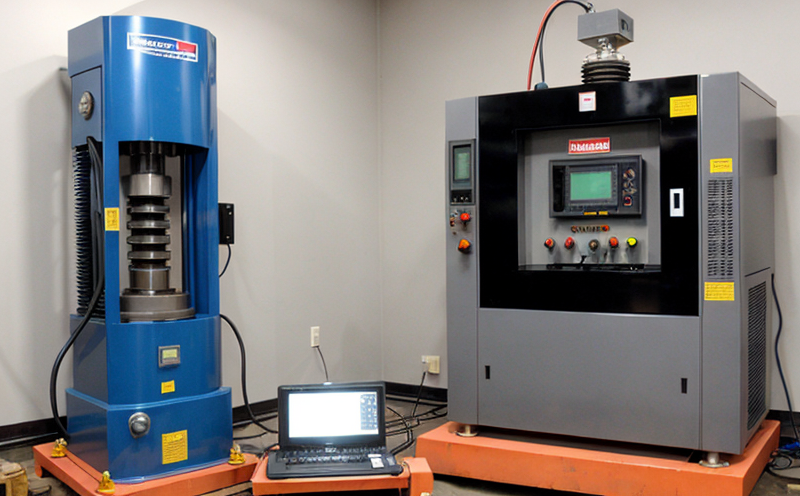ASTM E1049 Vibration Fatigue Testing for Materials
The ASTM E1049 standard is a critical tool in the evaluation of materials subjected to cyclic mechanical stress. This test measures how a material responds under repeated, random vibration forces that simulate real-world conditions, such as those encountered during transportation or operation in harsh environments.
Understanding vibration fatigue is essential for ensuring the durability and reliability of electronic components across various industries including automotive, aerospace, and consumer electronics. The test simulates the cumulative effect of stress cycles on materials, which can lead to unexpected failures if not properly assessed.
The ASTM E1049 test setup involves mounting a specimen onto a shaker table that generates random vibration signals over a specified frequency range. The intensity of these vibrations is controlled by adjusting parameters such as amplitude and frequency. Specimens are typically tested under multiple stress levels to determine the lowest number of cycles required for failure.
The methodology ensures that materials used in critical applications undergo rigorous scrutiny, allowing manufacturers to select robust components that can withstand long-term operational conditions without degradation. This is particularly important for electronic devices where reliability is paramount. By conducting this test early in the development process, engineers can identify potential weaknesses and make necessary design modifications.
The ASTM E1049 protocol is widely used because it provides a standardized approach to testing that allows for consistent results across different laboratories. This consistency enhances confidence in the data generated from these tests, making them indispensable tools for quality assurance processes.
For instance, automotive manufacturers rely on ASTM E1049 to ensure that their electronic control units (ECUs) and other critical components can endure the shocks and vibrations experienced during vehicle transport. Similarly, aerospace companies use this test to verify that avionics systems remain functional after exposure to extreme environmental conditions.
In summary, ASTM E1049 vibration fatigue testing is a vital step in ensuring the longevity and reliability of materials used in electronic devices. It helps manufacturers identify potential issues early on, thereby reducing costly repairs or replacements later in the product lifecycle.
Why It Matters
Vibration fatigue testing is crucial for industries where robustness and reliability are non-negotiable. By simulating real-world conditions, this test ensures that materials used in electronics can withstand the stresses they will encounter during use.
The primary benefit of ASTM E1049 lies in its ability to predict how a material will perform under repeated stress cycles. This foresight allows manufacturers to make informed decisions about design and manufacturing processes, ultimately leading to more durable products.
For quality managers and compliance officers, this test provides essential data for ensuring adherence to industry standards. It also supports the development of new materials by identifying their limits and potential improvements areas.
R&D engineers can leverage ASTM E1049 results to refine designs and improve product performance. By incorporating feedback from these tests into their design iterations, they can create more resilient electronic components that meet stringent quality expectations.
Procurement teams find value in ASTM E1049 as it helps them select suppliers who adhere to rigorous testing protocols. This ensures that the materials they source are up to industry standards and capable of enduring the intended operational conditions.
Quality and Reliability Assurance
The ASTM E1049 vibration fatigue test is an integral part of a comprehensive quality assurance program aimed at ensuring reliability. This test assesses how materials respond to cyclic mechanical stress, which is essential for maintaining consistent performance levels over extended periods.
By conducting this test, labs can identify any weaknesses in the materials used in electronic devices before they are deployed into production. Early detection of these issues allows manufacturers to address them promptly, thereby enhancing overall product quality and customer satisfaction.
The results from ASTM E1049 tests provide valuable insights that inform critical decisions regarding material selection and process optimization. These data points enable companies to enhance their supply chain management practices by selecting suppliers who meet stringent testing criteria.
Furthermore, compliance with ASTM E1049 helps organizations maintain regulatory standards set forth by governing bodies. This adherence not only protects them from potential legal challenges but also strengthens brand reputation among customers and stakeholders.
Competitive Advantage and Market Impact
Adopting ASTM E1049 vibration fatigue testing offers significant competitive advantages in today's highly competitive market. This approach ensures that electronic devices are built with materials capable of enduring the rigors of real-world use.
Companies that invest in ASTM E1049 tests gain a strategic edge over competitors by delivering products known for their reliability and durability. Such commitment to quality fosters trust among customers, enhancing brand loyalty and market share.
The ability to predict material failure through rigorous testing enables manufacturers to innovate more effectively. By identifying potential shortcomings early in the development process, they can introduce new features or improvements based on empirical evidence rather than conjecture.
Moreover, compliance with ASTM E1049 standards demonstrates a company's commitment to excellence and ethical business practices. This aligns them closely with consumer expectations regarding product safety and environmental sustainability.





